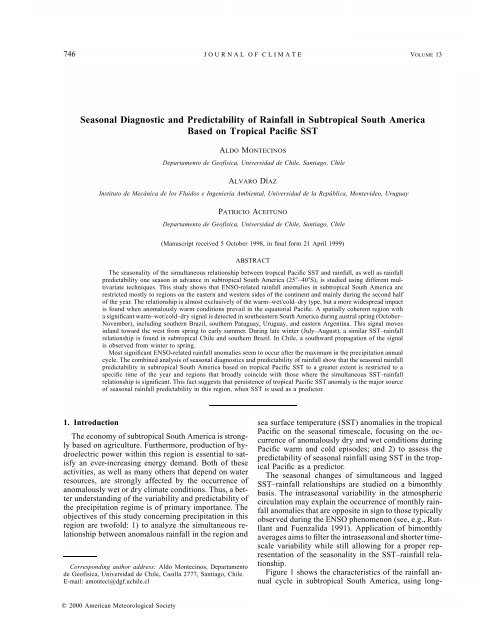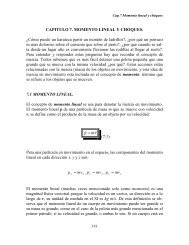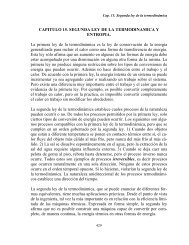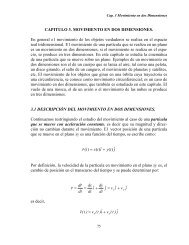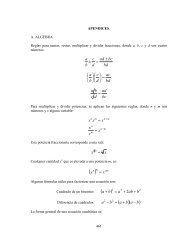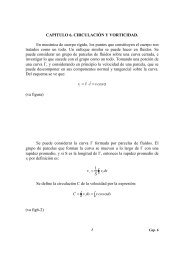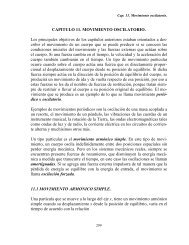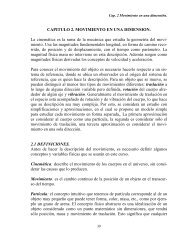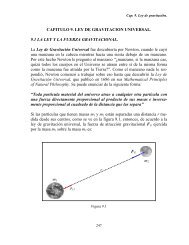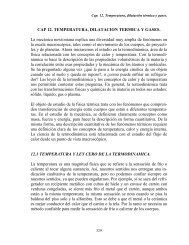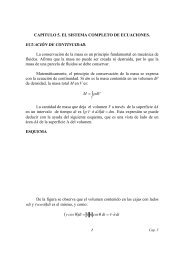Seasonal Diagnostic and Predictability of Rainfall in Subtropical ...
Seasonal Diagnostic and Predictability of Rainfall in Subtropical ...
Seasonal Diagnostic and Predictability of Rainfall in Subtropical ...
You also want an ePaper? Increase the reach of your titles
YUMPU automatically turns print PDFs into web optimized ePapers that Google loves.
746 JOURNAL OF CLIMATE<br />
VOLUME 13<br />
<strong>Seasonal</strong> <strong>Diagnostic</strong> <strong>and</strong> <strong>Predictability</strong> <strong>of</strong> <strong>Ra<strong>in</strong>fall</strong> <strong>in</strong> <strong>Subtropical</strong> South America<br />
Based on Tropical Pacific SST<br />
ALDO MONTECINOS<br />
Departamento de Ge<strong>of</strong>ísica, Universidad de Chile, Santiago, Chile<br />
ALVARO DÍAZ<br />
Instituto de Mecánica de los Fluídos e Ingeniería Ambiental, Universidad de la República, Montevideo, Uruguay<br />
PATRICIO ACEITUNO<br />
Departamento de Ge<strong>of</strong>ísica, Universidad de Chile, Santiago, Chile<br />
(Manuscript received 5 October 1998, <strong>in</strong> f<strong>in</strong>al form 21 April 1999)<br />
ABSTRACT<br />
The seasonality <strong>of</strong> the simultaneous relationship between tropical Pacific SST <strong>and</strong> ra<strong>in</strong>fall, as well as ra<strong>in</strong>fall<br />
predictability one season <strong>in</strong> advance <strong>in</strong> subtropical South America (25–40S), is studied us<strong>in</strong>g different multivariate<br />
techniques. This study shows that ENSO-related ra<strong>in</strong>fall anomalies <strong>in</strong> subtropical South America are<br />
restricted mostly to regions on the eastern <strong>and</strong> western sides <strong>of</strong> the cont<strong>in</strong>ent <strong>and</strong> ma<strong>in</strong>ly dur<strong>in</strong>g the second half<br />
<strong>of</strong> the year. The relationship is almost exclusively <strong>of</strong> the warm–wet/cold–dry type, but a more widespread impact<br />
is found when anomalously warm conditions prevail <strong>in</strong> the equatorial Pacific. A spatially coherent region with<br />
a significant warm–wet/cold–dry signal is detected <strong>in</strong> southeastern South America dur<strong>in</strong>g austral spr<strong>in</strong>g (October–<br />
November), <strong>in</strong>clud<strong>in</strong>g southern Brazil, southern Paraguay, Uruguay, <strong>and</strong> eastern Argent<strong>in</strong>a. This signal moves<br />
<strong>in</strong>l<strong>and</strong> toward the west from spr<strong>in</strong>g to early summer. Dur<strong>in</strong>g late w<strong>in</strong>ter (July–August), a similar SST–ra<strong>in</strong>fall<br />
relationship is found <strong>in</strong> subtropical Chile <strong>and</strong> southern Brazil. In Chile, a southward propagation <strong>of</strong> the signal<br />
is observed from w<strong>in</strong>ter to spr<strong>in</strong>g.<br />
Most significant ENSO-related ra<strong>in</strong>fall anomalies seem to occur after the maximum <strong>in</strong> the precipitation annual<br />
cycle. The comb<strong>in</strong>ed analysis <strong>of</strong> seasonal diagnostics <strong>and</strong> predictability <strong>of</strong> ra<strong>in</strong>fall show that the seasonal ra<strong>in</strong>fall<br />
predictability <strong>in</strong> subtropical South America based on tropical Pacific SST to a greater extent is restricted to a<br />
specific time <strong>of</strong> the year <strong>and</strong> regions that broadly co<strong>in</strong>cide with those where the simultaneous SST–ra<strong>in</strong>fall<br />
relationship is significant. This fact suggests that persistence <strong>of</strong> tropical Pacific SST anomaly is the major source<br />
<strong>of</strong> seasonal ra<strong>in</strong>fall predictability <strong>in</strong> this region, when SST is used as a predictor.<br />
1. Introduction<br />
The economy <strong>of</strong> subtropical South America is strongly<br />
based on agriculture. Furthermore, production <strong>of</strong> hydroelectric<br />
power with<strong>in</strong> this region is essential to satisfy<br />
an ever-<strong>in</strong>creas<strong>in</strong>g energy dem<strong>and</strong>. Both <strong>of</strong> these<br />
activities, as well as many others that depend on water<br />
resources, are strongly affected by the occurrence <strong>of</strong><br />
anomalously wet or dry climate conditions. Thus, a better<br />
underst<strong>and</strong><strong>in</strong>g <strong>of</strong> the variability <strong>and</strong> predictability <strong>of</strong><br />
the precipitation regime is <strong>of</strong> primary importance. The<br />
objectives <strong>of</strong> this study concern<strong>in</strong>g precipitation <strong>in</strong> this<br />
region are tw<strong>of</strong>old: 1) to analyze the simultaneous relationship<br />
between anomalous ra<strong>in</strong>fall <strong>in</strong> the region <strong>and</strong><br />
Correspond<strong>in</strong>g author address: Aldo Montec<strong>in</strong>os, Departamento<br />
de Ge<strong>of</strong>ísica, Universidad de Chile, Casilla 2777, Santiago, Chile.<br />
E-mail: amonteci@dgf.uchile.cl<br />
sea surface temperature (SST) anomalies <strong>in</strong> the tropical<br />
Pacific on the seasonal timescale, focus<strong>in</strong>g on the occurrence<br />
<strong>of</strong> anomalously dry <strong>and</strong> wet conditions dur<strong>in</strong>g<br />
Pacific warm <strong>and</strong> cold episodes; <strong>and</strong> 2) to assess the<br />
predictability <strong>of</strong> seasonal ra<strong>in</strong>fall us<strong>in</strong>g SST <strong>in</strong> the tropical<br />
Pacific as a predictor.<br />
The seasonal changes <strong>of</strong> simultaneous <strong>and</strong> lagged<br />
SST–ra<strong>in</strong>fall relationships are studied on a bimonthly<br />
basis. The <strong>in</strong>traseasonal variability <strong>in</strong> the atmospheric<br />
circulation may expla<strong>in</strong> the occurrence <strong>of</strong> monthly ra<strong>in</strong>fall<br />
anomalies that are opposite <strong>in</strong> sign to those typically<br />
observed dur<strong>in</strong>g the ENSO phenomenon (see, e.g., Rutllant<br />
<strong>and</strong> Fuenzalida 1991). Application <strong>of</strong> bimonthly<br />
averages aims to filter the <strong>in</strong>traseasonal <strong>and</strong> shorter timescale<br />
variability while still allow<strong>in</strong>g for a proper representation<br />
<strong>of</strong> the seasonality <strong>in</strong> the SST–ra<strong>in</strong>fall relationship.<br />
Figure 1 shows the characteristics <strong>of</strong> the ra<strong>in</strong>fall annual<br />
cycle <strong>in</strong> subtropical South America, us<strong>in</strong>g long-<br />
2000 American Meteorological Society
15 FEBRUARY 2000 MONTECINOS ET AL.<br />
747<br />
FIG. 1. Bimonthly ra<strong>in</strong>fall climatology (left panels) dur<strong>in</strong>g 1947–86, <strong>and</strong> monthly differences dur<strong>in</strong>g each bimonthly <strong>in</strong>terval (right panels):<br />
Jan–Feb, Mar–Apr, May–Jun, Jul–Aug, Sep–Oct, Nov–Dec. Symbols are described at the bottom <strong>of</strong> the figure.<br />
term averages <strong>and</strong> ra<strong>in</strong>fall changes dur<strong>in</strong>g nonoverlapp<strong>in</strong>g<br />
bimonthly <strong>in</strong>tervals. Four sectors with ra<strong>in</strong>fall hav<strong>in</strong>g<br />
a relatively homogeneous annual cycle are identified:<br />
the Pacific coastal b<strong>and</strong> (central Chile), the<br />
cont<strong>in</strong>ental strip on the east side <strong>of</strong> the Andes (70–<br />
65W), the central cont<strong>in</strong>ental strip (65–60W), <strong>and</strong> the<br />
Atlantic b<strong>and</strong> east <strong>of</strong> 60W.<br />
1) Pacific b<strong>and</strong> (central Chile): This sector corresponds<br />
to the narrow cont<strong>in</strong>ental strip between the Pacific<br />
coast <strong>and</strong> the Andes Mounta<strong>in</strong>s. There is a welldef<strong>in</strong>ed<br />
contrast between the extreme <strong>and</strong> permanent<br />
arid conditions prevail<strong>in</strong>g <strong>in</strong> the northern sector <strong>and</strong><br />
the wetter conditions <strong>in</strong> the south. Although there is<br />
some <strong>in</strong>crease <strong>in</strong> ra<strong>in</strong>fall from February to March,<br />
the largest seasonal <strong>in</strong>crease occurs between April<br />
<strong>and</strong> May. From June to July the change <strong>in</strong> ra<strong>in</strong>fall<br />
is relatively small, although a slight <strong>in</strong>crease is observed<br />
northward <strong>of</strong> approximately 33S <strong>and</strong> a decrease<br />
<strong>in</strong> the region to the south <strong>of</strong> this latitude. The<br />
significant decrease <strong>in</strong> ra<strong>in</strong>fall dur<strong>in</strong>g August–September<br />
<strong>in</strong>dicates the end <strong>of</strong> the wet season.<br />
2) Cont<strong>in</strong>ental strip eastward from the Andes (70–<br />
65W): The region east <strong>of</strong> the Andes is relatively<br />
dry. This is partially due to the ra<strong>in</strong> shadow effect<br />
<strong>of</strong> the Andes, associated with the midlatitude westerly<br />
flow. The meridional variation <strong>of</strong> ra<strong>in</strong>fall <strong>and</strong><br />
its seasonality are broadly opposite to those described<br />
for Chile. Accord<strong>in</strong>gly, Fig. 1 shows that<br />
ra<strong>in</strong>fall <strong>in</strong>creases from September to January. In the<br />
southern portion <strong>of</strong> this region, relatively dry conditions<br />
prevail throughout the year (average ra<strong>in</strong>fall<br />
less than 50 mm <strong>in</strong> each bimonthly period).<br />
3) Central cont<strong>in</strong>ental strip (65–60W): Here, the annual<br />
cycle <strong>of</strong> ra<strong>in</strong>fall is characterized by a m<strong>in</strong>imum<br />
dur<strong>in</strong>g w<strong>in</strong>ter (May–August) <strong>and</strong> a maximum dur<strong>in</strong>g<br />
summer <strong>and</strong> early fall (January–April). The slow <strong>in</strong>crease<br />
<strong>in</strong> ra<strong>in</strong>fall observed dur<strong>in</strong>g the summer semester<br />
ends <strong>in</strong> March <strong>and</strong> it is followed by a relatively<br />
fast decrease dur<strong>in</strong>g April <strong>and</strong> May.<br />
4) Atlantic b<strong>and</strong> east <strong>of</strong> 60W: This region <strong>in</strong>cludes the<br />
southern part <strong>of</strong> Paraguay, southern Brazil, Uruguay,<br />
<strong>and</strong> the pampas sector <strong>of</strong> eastern Argent<strong>in</strong>a. Although<br />
precipitation is larger <strong>in</strong> the northern sector,<br />
the entire region is characterized by a relatively flat<br />
annual cycle with bimonthly ra<strong>in</strong>fall exceed<strong>in</strong>g 100<br />
mm dur<strong>in</strong>g the entire year. The seasonal changes <strong>in</strong><br />
ra<strong>in</strong>fall show some dist<strong>in</strong>ct features, such as the relatively<br />
large <strong>in</strong>crease dur<strong>in</strong>g the transition from w<strong>in</strong>ter<br />
to spr<strong>in</strong>g (August–September) <strong>in</strong> the northern sector<br />
<strong>of</strong> the region (southern Brazil, southern Paraguay,<br />
<strong>and</strong> northeastern Argent<strong>in</strong>a), which is followed by a<br />
decrease dur<strong>in</strong>g spr<strong>in</strong>g (October–November), <strong>in</strong> contrast<br />
with the overall <strong>in</strong>crease observed elsewhere <strong>in</strong><br />
Argent<strong>in</strong>a.<br />
Several studies support the existence <strong>of</strong> l<strong>in</strong>ks between<br />
the Southern Oscillation (<strong>and</strong> associated SST anomalies
748 JOURNAL OF CLIMATE<br />
VOLUME 13<br />
<strong>in</strong> the tropical Pacific) with precipitation anomalies <strong>in</strong><br />
subtropical South America.<br />
A warm–wet/cold–dry relationship has been documented<br />
for central Chile dur<strong>in</strong>g austral w<strong>in</strong>ter (Rub<strong>in</strong><br />
1955; Pittock 1980; Qu<strong>in</strong>n <strong>and</strong> Neal 1983; Aceituno<br />
1988; Kiladis <strong>and</strong> Díaz 1989). Rub<strong>in</strong> (1955) documented<br />
a tendency for below-normal precipitation <strong>in</strong><br />
central Chile when the subtropical anticyclone <strong>in</strong> the<br />
southeastern Pacific is anomalously <strong>in</strong>tense dur<strong>in</strong>g the<br />
positive phase <strong>of</strong> the Southern Oscillation. Rutllant <strong>and</strong><br />
Fuenzalida (1991) confirmed the warm–wet/cold–dry<br />
tendency, po<strong>in</strong>t<strong>in</strong>g out that major w<strong>in</strong>ter storms associated<br />
with warm events are related to block<strong>in</strong>g <strong>in</strong> the<br />
Bell<strong>in</strong>gshausen Sea area (90W). They also called the<br />
attention to the occurrence <strong>of</strong> dry months dur<strong>in</strong>g wet<br />
w<strong>in</strong>ters <strong>in</strong> El Niño years, <strong>in</strong>terpret<strong>in</strong>g this as the effect<br />
<strong>of</strong> <strong>in</strong>traseasonal variability characterized by alternat<strong>in</strong>g<br />
circulation anomaly patterns at subtropical latitudes.<br />
Pittock (1980) documents the existence <strong>of</strong> a significant<br />
negative correlation between the Southern Oscillation<br />
<strong>in</strong>dex (SOI) <strong>and</strong> precipitation over eastern Argent<strong>in</strong>a<br />
dur<strong>in</strong>g spr<strong>in</strong>g. For southeastern South America,<br />
which <strong>in</strong>cludes southern Brazil, Uruguay, <strong>and</strong> part <strong>of</strong><br />
northeastern Argent<strong>in</strong>a, Ropelewski <strong>and</strong> Halpert (1987,<br />
1989) documented a clear tendency for enhanced precipitation<br />
dur<strong>in</strong>g spr<strong>in</strong>g <strong>and</strong> summer dur<strong>in</strong>g El Niño<br />
years, <strong>and</strong> a tendency for below-normal precipitation<br />
dur<strong>in</strong>g high SOI years, between June <strong>and</strong> December.<br />
This results have been confirmed by Pisciottano et al.<br />
(1994) for Uruguay <strong>and</strong> Grimm et al. (1998) for southern<br />
Brazil. Moreover, Pisciottano et al. (1994) found<br />
that dur<strong>in</strong>g El Niño (La Niña) events there is a tendency<br />
to have higher (lower) than average ra<strong>in</strong>fall from March<br />
to July (year 1). Díaz et al. (1998) show that both<br />
Pacific <strong>and</strong> Atlantic SST anomalies <strong>in</strong>fluence the ra<strong>in</strong>fall<br />
regime <strong>in</strong> Uruguay <strong>and</strong> southern Brazil (state <strong>of</strong> Rio<br />
Gr<strong>and</strong>e do Sul) dur<strong>in</strong>g austral spr<strong>in</strong>g <strong>and</strong> summer, although<br />
dur<strong>in</strong>g the fall–w<strong>in</strong>ter period (April–July) only<br />
the SST anomalies <strong>in</strong> the southwestern Atlantic seem<br />
to have an <strong>in</strong>fluence on ra<strong>in</strong>fall anomalies <strong>in</strong> this region.<br />
Descriptions <strong>of</strong> precipitation <strong>and</strong> SST data <strong>and</strong> their<br />
preprocess<strong>in</strong>g are found <strong>in</strong> section 2. Sections 3 <strong>and</strong> 4<br />
outl<strong>in</strong>e the analysis techniques <strong>and</strong> document the seasonality<br />
<strong>and</strong> spatial characteristics <strong>of</strong> the simultaneous<br />
SST–ra<strong>in</strong>fall relationship, <strong>and</strong> <strong>of</strong> the seasonal ra<strong>in</strong>fall<br />
predictability based on tropical Pacific SST. F<strong>in</strong>ally, section<br />
5 conta<strong>in</strong>s the most relevant results <strong>and</strong> conclusions.<br />
2. Data<br />
a. Precipitation<br />
The ma<strong>in</strong> ra<strong>in</strong>fall dataset for this study <strong>in</strong>cludes<br />
monthly totals from 106 stations <strong>in</strong> the subtropical sector<br />
<strong>of</strong> South America (25–40S) cover<strong>in</strong>g the period<br />
December 1946–December 1986. To assess the stability<br />
<strong>of</strong> some results, a second dataset with monthly ra<strong>in</strong>fall<br />
values from 79 stations dur<strong>in</strong>g the period December<br />
1918–December 1989 was used. Most <strong>of</strong> the ra<strong>in</strong>fall<br />
records are complete, while those that are not have less<br />
than 5% <strong>of</strong> miss<strong>in</strong>g data.<br />
This dataset was compiled by Servicio Meteorológico<br />
Nacional (Argent<strong>in</strong>a), Dirección Meteorológica de Chile<br />
(Chile), Dirección General de Aguas (Chile), Instituto<br />
de Pesquisas Agronómicas do Rio Gr<strong>and</strong>e do Sul (Brazil),<br />
Instituto Nacional de Meteorología (Brazil), Dirección<br />
Nacional de Meteorología (Uruguay), <strong>and</strong> Dirección<br />
de Meteorología (Paraguay). The data was provided<br />
by 46 stations <strong>in</strong> Argent<strong>in</strong>a, 25 <strong>in</strong> Chile, 21 <strong>in</strong><br />
southern Brazil (state <strong>of</strong> Rio Gr<strong>and</strong>e do Sul), 11 <strong>in</strong><br />
Uruguay, <strong>and</strong> 3 <strong>in</strong> southern Paraguay. No ra<strong>in</strong>fall data<br />
were considered for the arid region <strong>of</strong> northern Chile.<br />
Indeed, data coverage is relatively poor <strong>in</strong> Paraguay, the<br />
state <strong>of</strong> Santa Catar<strong>in</strong>a <strong>in</strong> southern Brazil, <strong>and</strong> <strong>in</strong> northern<br />
<strong>and</strong> southern Argent<strong>in</strong>a.<br />
b. Sea surface temperature<br />
For the period 1946–81 monthly mean values <strong>of</strong> SST<br />
were obta<strong>in</strong>ed from the Global Ocean–Global Atmosphere<br />
dataset. This is an analysis <strong>of</strong> the Comprehensive<br />
Ocean Atmosphere Data Set produced at the Geophysical<br />
Fluid Dynamics Laboratory (Lau <strong>and</strong> Nath 1994).<br />
SST data, which are available on a grid with a 4.5 <br />
7.5 lat–long resolution, were extracted for the 244 grid<br />
po<strong>in</strong>ts <strong>in</strong> the region 20N–40S, 150E–80W. For the<br />
period 1982–86, monthly mean values correspond<strong>in</strong>g to<br />
the optimum <strong>in</strong>terpolation SST data (Reynolds <strong>and</strong><br />
Smith 1994) were used. This SST dataset, which is<br />
available at a 1 1 lat–long resolution, was <strong>in</strong>terpolated<br />
to the 4.5 7.5 lat–long grid us<strong>in</strong>g a cubic<br />
<strong>in</strong>terpolation method.<br />
The average SST anomaly <strong>in</strong> the Niño-3 region (5N–<br />
5S <strong>and</strong> 150–90W) was taken as an <strong>in</strong>dex for the SST<br />
conditions along the equatorial Pacific dur<strong>in</strong>g the period<br />
1950–89. For the period December 1918–December<br />
1949 the monthly time series <strong>of</strong> SST anomalies, calculated<br />
by Wright (1989), was used for the region def<strong>in</strong>ed<br />
by 6–2N, 170–90W; 2N–6S, 180–90W; 6–<br />
10S, 150–110W.<br />
c. Data preprocess<strong>in</strong>g<br />
Bimonthly SST anomalies were calculated at each<br />
grid po<strong>in</strong>t by subtract<strong>in</strong>g the long-term mean from <strong>in</strong>dividual<br />
bimonthly averages. Time series <strong>of</strong> accumulated<br />
bimonthly ra<strong>in</strong>fall were calculated at each station.<br />
The first bimonthly <strong>in</strong>terval is December 1946–January<br />
1947 <strong>and</strong> the last is November–December 1986. These<br />
procedures yield twelve bimonthly time series (each 40<br />
yr long) for each field. For the sake <strong>of</strong> simplicity bimonthly<br />
periods will be usually referred to as DJ, JF,<br />
FM, MA, AM, MJ, JJ, JA, AS, SO, ON, <strong>and</strong> ND.
15 FEBRUARY 2000 MONTECINOS ET AL.<br />
749<br />
TABLE 1. Expla<strong>in</strong>ed variance (%) by the first pr<strong>in</strong>cipal component <strong>of</strong> Pacific SST anomaly <strong>in</strong> the region 20N–40S, 150E–80W, for each<br />
<strong>of</strong> 12 slid<strong>in</strong>g bimonthly <strong>in</strong>tervals: Jan–Feb, Feb–Mar up to Dec–Jan.<br />
Months JF FM MA AM MJ JJ JA AS SO ON ND DJ<br />
Variance (%) 36.8 31.0 27.5 28.5 32.3 34.3 36.0 40.6 44.7 46.8 46.2 42.0<br />
3. Simultaneous relationship between SST <strong>and</strong><br />
precipitation<br />
The simultaneous relationship between SST <strong>in</strong> the<br />
tropical Pacific <strong>and</strong> precipitation <strong>in</strong> subtropical South<br />
America is <strong>in</strong>vestigated us<strong>in</strong>g two different techniques.<br />
First, the l<strong>in</strong>ear relationship between the first pr<strong>in</strong>cipal<br />
component <strong>of</strong> the SST field <strong>and</strong> ra<strong>in</strong>fall at <strong>in</strong>dividual<br />
stations is evaluated us<strong>in</strong>g correlation analysis. In the<br />
second approach, the ra<strong>in</strong>fall anomalies dur<strong>in</strong>g extreme<br />
warm <strong>and</strong> cold conditions <strong>in</strong> the central equatorial Pacific<br />
are studied through a stratification procedure. Consider<strong>in</strong>g<br />
the strong seasonality <strong>of</strong> the ra<strong>in</strong>fall regime <strong>in</strong><br />
certa<strong>in</strong> regions (Fig. 1) for a particular bimonthly period,<br />
those stations hav<strong>in</strong>g at least one-third <strong>of</strong> the record<br />
with zero precipitation were excluded from both analyses.<br />
a. Correlation analysis<br />
Pr<strong>in</strong>cipal component analysis was applied to bimonthly<br />
fields <strong>of</strong> Pacific SST <strong>in</strong> the region 20N–40S,<br />
150E–80W. The dom<strong>in</strong>ant first component captures<br />
most <strong>of</strong> the <strong>in</strong>terannual variability related to ENSO,<br />
although the percentage <strong>of</strong> the expla<strong>in</strong>ed variance has<br />
a strong seasonality (Table 1), with the m<strong>in</strong>imum value<br />
<strong>in</strong> fall (27% <strong>in</strong> MA) <strong>and</strong> maximum <strong>in</strong> spr<strong>in</strong>g (47% <strong>in</strong><br />
ON). In fact, the SST <strong>in</strong>dex built by comb<strong>in</strong><strong>in</strong>g the PC1s<br />
calculated for bimonthly <strong>in</strong>tervals has a strong correlation<br />
with the Niño-3 series <strong>of</strong> SST anomaly, <strong>and</strong> its<br />
periods <strong>of</strong> anomalously high <strong>and</strong> low values (Fig. 2a)<br />
very closely co<strong>in</strong>cide with the tim<strong>in</strong>g <strong>of</strong> El Niño <strong>and</strong><br />
La Niña episodes <strong>in</strong> the equatorial Pacific, accord<strong>in</strong>g to<br />
Trenberth (1997). Moreover, the pattern <strong>of</strong> correlation<br />
between the spatially <strong>in</strong>tegrated SST <strong>in</strong>dex formed with<br />
the bimonthly PC1s <strong>and</strong> the actual SST anomalies at<br />
grid po<strong>in</strong>ts (Fig. 2b) also has a close resemblance to the<br />
composite SST anomaly pattern described by Rasmusson<br />
<strong>and</strong> Carpenter (1982) for the transition <strong>and</strong> mature<br />
phases <strong>of</strong> the El Niño phenomenon.<br />
For each bimonthly period the correlation between<br />
the PC1 <strong>and</strong> ra<strong>in</strong>fall at <strong>in</strong>dividual stations was calculated.<br />
Accord<strong>in</strong>g to a st<strong>and</strong>ard Student’s t-test, correlations<br />
larger than 0.5 <strong>in</strong> magnitude are highly significant<br />
(at a 0.2% level), while those larger than 0.3 <strong>in</strong><br />
magnitude are significant at the 6% level. To obta<strong>in</strong> a<br />
global measure <strong>of</strong> the l<strong>in</strong>ear relationship between PC1<br />
<strong>and</strong> precipitation, the percentage <strong>of</strong> ra<strong>in</strong>fall stations hav<strong>in</strong>g<br />
significant positive correlations was calculated for<br />
each bimonthly <strong>in</strong>terval (Table 2). This percentage is<br />
maximum dur<strong>in</strong>g the austral spr<strong>in</strong>g (72% <strong>in</strong> ND <strong>and</strong><br />
63% <strong>in</strong> ON) <strong>and</strong> m<strong>in</strong>imum dur<strong>in</strong>g austral fall (2% <strong>in</strong><br />
MA <strong>and</strong> 4% <strong>in</strong> AM), which co<strong>in</strong>cides with the periods<br />
<strong>of</strong> the year when the percentage <strong>of</strong> SST variance expla<strong>in</strong>ed<br />
by the first pr<strong>in</strong>cipal component is highest <strong>and</strong><br />
lowest <strong>in</strong> the annual cycle, respectively (see Table 1).<br />
Overall, Table 2 <strong>in</strong>dicates that the tropical Pacific SST<br />
plays a relatively larger role <strong>in</strong> modulat<strong>in</strong>g <strong>in</strong>terannual<br />
ra<strong>in</strong>fall variability <strong>in</strong> subtropical South America dur<strong>in</strong>g<br />
the second semester <strong>of</strong> the year, especially dur<strong>in</strong>g late<br />
spr<strong>in</strong>g (October–December). The seasonality <strong>in</strong> the percentage<br />
<strong>of</strong> significant negative correlations is not shown<br />
as the warm–wet/cold–dry relationships are strongly<br />
prevalent <strong>in</strong> this part <strong>of</strong> South America.<br />
Bimonthly patterns <strong>of</strong> the correlation between PC1<br />
<strong>and</strong> ra<strong>in</strong>fall are presented <strong>in</strong> Fig. 3. The correlation<br />
method was not applied at stations where the dry season<br />
is characterized by the total absence <strong>of</strong> ra<strong>in</strong>fall, as <strong>in</strong><br />
Chile (30–35S) dur<strong>in</strong>g the summer semester (October–<br />
March).<br />
Dur<strong>in</strong>g the austral summer, weak negative correlations<br />
appear <strong>in</strong> central–southern Chile <strong>and</strong> adjacent stations<br />
<strong>in</strong> Argent<strong>in</strong>a. In DJ positive significant values are<br />
predom<strong>in</strong>antly located along a longitud<strong>in</strong>al b<strong>and</strong> identified<br />
as the central cont<strong>in</strong>ental strip. Later on, from JF<br />
to AM, few stations show significant correlations. In<br />
MJ, a weak signal appears <strong>in</strong> central Chile; this signal<br />
enhances dur<strong>in</strong>g JJ when significant positive correlations<br />
appear from 30 to 34S. In JA, the region with<br />
positive significant values <strong>in</strong> Chile extends southward<br />
to 37S <strong>and</strong> the same signal appears at stations <strong>in</strong> the<br />
northern part <strong>of</strong> Rio Gr<strong>and</strong>e do Sul (26–30S).<br />
From AS to DJ, highly significant correlations (i.e.,<br />
larger than 0.5) appear <strong>in</strong> all bimonthly periods, but they<br />
are mostly concentrated <strong>in</strong> Chile <strong>and</strong> along the eastern<br />
part <strong>of</strong> subtropical South America. In Chile, the pattern<br />
described for JA strengthens dur<strong>in</strong>g AS, although a<br />
weaken<strong>in</strong>g <strong>in</strong> the magnitude <strong>of</strong> positive correlations are<br />
apparent <strong>in</strong> the northern sector. In SO, the signal <strong>in</strong> Chile<br />
weakens <strong>in</strong> the northern sector <strong>and</strong> enhances farther<br />
south, reach<strong>in</strong>g the southernmost position dur<strong>in</strong>g ON.<br />
From AS to ND, positive correlations prevail along the<br />
eastern part <strong>of</strong> subtropical South America. The values<br />
are highly significant dur<strong>in</strong>g ON, especially <strong>in</strong> southern<br />
Brazil, northern Uruguay, <strong>and</strong> northeastern Argent<strong>in</strong>a.<br />
Dur<strong>in</strong>g ND this pattern <strong>of</strong> positive correlation weakens<br />
<strong>in</strong> the northeast <strong>and</strong> shifts westward. This process cont<strong>in</strong>ues<br />
<strong>in</strong> DJ, with the correlation pattern described previously<br />
for this bimonthly <strong>in</strong>terval.<br />
b. Stratification analysis<br />
The SST–ra<strong>in</strong>fall relationship dur<strong>in</strong>g warm <strong>and</strong> cold<br />
conditions <strong>in</strong> the equatorial Pacific was analyzed on a
750 JOURNAL OF CLIMATE<br />
VOLUME 13<br />
FIG. 2. (a) Comb<strong>in</strong>ed SST PC1 time series from Dec 1946–Jan 1947 to Nov–Dec 1986. Warm <strong>and</strong> cold periods <strong>in</strong> the equatorial Pacific<br />
accord<strong>in</strong>g to Trenberth (1997) are <strong>in</strong>dicated. (b) Correlation scores between comb<strong>in</strong>ed SST PC1 <strong>and</strong> SST anomaly consider<strong>in</strong>g all bimonthly<br />
<strong>in</strong>tervals <strong>in</strong> the period 1947–86.<br />
bimonthly basis us<strong>in</strong>g a stratification technique. This<br />
procedure differs from those performed on an annual<br />
basis, us<strong>in</strong>g El Niño <strong>and</strong> La Niña years as <strong>in</strong>dicators <strong>of</strong><br />
warm <strong>and</strong> cold conditions (i.e., Ropelewski <strong>and</strong> Halpert<br />
1987, 1989). Here, anomalously warm <strong>and</strong> cold conditions<br />
were identified on a bimonthly basis as those<br />
when the central equatorial Pacific SST is <strong>in</strong> the highest<br />
<strong>and</strong> lowest 20% <strong>of</strong> the empirical distribution dur<strong>in</strong>g the<br />
period 1947–86. In this way, eight warm <strong>and</strong> eight cold<br />
cases were identified for each bimonthly <strong>in</strong>terval. It<br />
should be noted that only 40% <strong>of</strong> the years are considered<br />
<strong>in</strong> this analysis, as the methodology does not address<br />
the SST–ra<strong>in</strong>fall relationship when the SST anomaly<br />
is <strong>in</strong> the range between the 20th <strong>and</strong> 80th percentiles.<br />
The warm <strong>and</strong> cold bimonthly <strong>in</strong>tervals def<strong>in</strong>ed by<br />
this stratification procedure broadly co<strong>in</strong>cide with the<br />
periods def<strong>in</strong>ed by Trenberth (1997) as El Niño <strong>and</strong> La<br />
Niña events dur<strong>in</strong>g the period 1950–86. Specifically,<br />
90% <strong>of</strong> the warm <strong>in</strong>tervals are part <strong>of</strong> El Niño events<br />
<strong>and</strong> 80% <strong>of</strong> the cold <strong>in</strong>tervals belong to La Niña epi-<br />
TABLE 2. Percentage <strong>of</strong> stations hav<strong>in</strong>g significant positive correlation between SST PC1 <strong>and</strong> precipitation <strong>in</strong> subtropical South America,<br />
dur<strong>in</strong>g 1947–86, for each <strong>of</strong> the 12 slid<strong>in</strong>g bimonthly <strong>in</strong>tervals: Jan–Feb, Feb–Mar up to Dec–Jan.<br />
Months JF FM MA AM MJ JJ JA AS SO ON ND DJ<br />
% 7.7 6.6 2.0 3.8 7.6 13.2 27.3 21.9 21.0 63.0 71.9 17.6
15 FEBRUARY 2000 MONTECINOS ET AL.<br />
751<br />
FIG. 3. Pattern <strong>of</strong> correlation between SST PC1 <strong>and</strong> ra<strong>in</strong>fall for each <strong>of</strong> the 12 slid<strong>in</strong>g bimonthly <strong>in</strong>tervals: Dec–Jan, Jan–Feb, Feb–Mar,<br />
up to Nov–Dec. Symbols <strong>in</strong>dicate magnitude <strong>and</strong> sign <strong>of</strong> correlation (see code <strong>in</strong> the figure). A magnitude larger than 0.30 is significant at<br />
the 6% level.<br />
sodes. In both cases most <strong>of</strong> the discrepancies are observed<br />
dur<strong>in</strong>g the first half <strong>of</strong> the year. It is also found<br />
that dur<strong>in</strong>g 1962, 1963, 1967, <strong>and</strong> 1968 the stratification<br />
technique identifies cold bimonthly <strong>in</strong>tervals that were<br />
not part <strong>of</strong> La Niña periods as def<strong>in</strong>ed by Trenberth<br />
(1997). There are also <strong>in</strong>tervals that co<strong>in</strong>cide with El<br />
Niño <strong>and</strong> La Niña events, but s<strong>in</strong>ce the associated SST<br />
anomalies are not <strong>in</strong> the extreme 20th percentile, our<br />
methodology does not consider them as warm <strong>and</strong> cold<br />
cases.<br />
Limits <strong>of</strong> the 20th <strong>and</strong> 80th percentiles <strong>of</strong> the empirical<br />
distribution <strong>of</strong> SST anomaly <strong>in</strong> the equatorial<br />
Pacific (Table 3) have a seasonality similar to that <strong>of</strong><br />
the variance expla<strong>in</strong>ed by the SST PC1 (Table 1). The
752 JOURNAL OF CLIMATE<br />
VOLUME 13<br />
TABLE 3. Central equatorial Pacific SST anomalies (<strong>in</strong> C) def<strong>in</strong><strong>in</strong>g limits <strong>of</strong> the (a) highest <strong>and</strong> (b) lowest 20% <strong>of</strong> its empirical distribution,<br />
<strong>and</strong> (c) st<strong>and</strong>ard deviation <strong>of</strong> SST anomaly, for each <strong>of</strong> the 12 slid<strong>in</strong>g bimonthly <strong>in</strong>tervals: Jan–Feb, Feb–Mar up to Dec–Jan.<br />
Months JF FM MA AM MJ JJ JA AS SO ON ND DJ<br />
Highest 20% (a)<br />
Lowest 20% (b)<br />
Std dev (c)<br />
0.64<br />
0.58<br />
0.86<br />
0.45<br />
0.38<br />
0.64<br />
0.38<br />
0.48<br />
0.54<br />
0.56<br />
0.47<br />
0.63<br />
0.56<br />
0.60<br />
0.72<br />
0.74<br />
0.60<br />
0.72<br />
0.89<br />
0.56<br />
0.77<br />
0.89<br />
0.73<br />
0.80<br />
0.91<br />
0.68<br />
0.87<br />
1.04<br />
0.76<br />
0.98<br />
1.08<br />
0.94<br />
1.09<br />
0.91<br />
0.72<br />
1.05<br />
largest span between both percentiles is observed <strong>in</strong><br />
November–December when the 20th <strong>and</strong> 80th percentiles<br />
correspond to 1.0 <strong>and</strong> 1.0C, approximately.<br />
The much lower <strong>in</strong>terannual SST variance dur<strong>in</strong>g fall<br />
(March–April) expla<strong>in</strong>s the relatively small SST anomalies<br />
correspond<strong>in</strong>g to those percentiles (0.5 <strong>and</strong><br />
0.4C, approximately).<br />
In regards to ra<strong>in</strong>fall, accumulated bimonthly values<br />
at each station were classified <strong>in</strong> dry, normal, <strong>and</strong> wet<br />
categories, us<strong>in</strong>g terciles <strong>of</strong> the empirical distribution as<br />
a classification rule. Then, for each bimonthly period<br />
the frequency <strong>of</strong> each category was determ<strong>in</strong>ed for the<br />
eight warm <strong>and</strong> eight cold years selected with the SST<br />
stratification procedure. Three possible conclusions may<br />
arise, namely, the existence <strong>of</strong> a shift <strong>in</strong> the ra<strong>in</strong>fall<br />
distribution toward the wet or toward the dry categories,<br />
or the absence <strong>of</strong> a clear deviation.<br />
It is particularly relevant to exam<strong>in</strong>e the occurrence<br />
(or absence) <strong>of</strong> extreme categories (dry <strong>and</strong> wet) when<br />
anomalous warm or cold conditions prevail <strong>in</strong> the Pacific.<br />
Then, the frequency <strong>of</strong> their occurrences are exam<strong>in</strong>ed<br />
<strong>and</strong> tested us<strong>in</strong>g an hypergeometric distribution<br />
(Feller 1957). Accord<strong>in</strong>g to this test, the occurrence <strong>of</strong><br />
at least five cases belong<strong>in</strong>g to one <strong>of</strong> the extreme categories<br />
(wet or dry) <strong>in</strong> the sample <strong>of</strong> eight warm (or<br />
cold) cases is statistically significant (5.7% level). These<br />
cases are called category-1 significant. Furthermore, the<br />
absence <strong>of</strong> one <strong>of</strong> the extreme categories (wet or dry)<br />
<strong>in</strong> those samples is highly significant (2.9% level).<br />
These cases, are called category-2 significant.<br />
Wetness <strong>and</strong> dryness <strong>in</strong>dices were def<strong>in</strong>ed to characterize<br />
statistically significant results for category 1 or<br />
2. When both are fulfilled, it will be said that the station<br />
belongs to W1 or D1 class, depend<strong>in</strong>g on whether wet<br />
or dry category is the predom<strong>in</strong>ant one. When the relationship<br />
is only category-1 significant, it will be said<br />
that the station belongs to the W2 or D2 class (depend<strong>in</strong>g<br />
if dom<strong>in</strong>ant categories are wet or dry). The rare<br />
cases <strong>of</strong> five occurrences <strong>in</strong> one extreme tercile <strong>and</strong> three<br />
<strong>in</strong> the opposite one were not considered <strong>in</strong> this classification,<br />
as it was subjectively considered that there is<br />
not a clear tendency for wet or dry conditions <strong>in</strong> this<br />
case. F<strong>in</strong>ally, when the relationship is only category-2<br />
significant, the station will be classified as NtD (not dry)<br />
or NtW (not wet). Excluded from this classification were<br />
the few cases when either the dry or wet category was<br />
not observed but the most frequent category was the<br />
normal one (five or more cases out <strong>of</strong> eight). The analysis<br />
described was performed at stations hav<strong>in</strong>g at most<br />
one-third <strong>of</strong> the record with zero values for each bimonthly<br />
<strong>in</strong>terval. In order to simplify, stations belong<strong>in</strong>g<br />
to the W1 class will be designated as W1 stations,<br />
etc.<br />
Spatial patterns <strong>of</strong> wetness <strong>and</strong> dryness <strong>in</strong>dices when<br />
anomalously warm conditions prevail <strong>in</strong> the central<br />
equatorial Pacific are shown <strong>in</strong> Fig. 4. Classes W1, W2,<br />
<strong>and</strong> NtD are predom<strong>in</strong>ant, <strong>in</strong>dicat<strong>in</strong>g that anomalously<br />
high SST is primarily associated with abundant ra<strong>in</strong>fall<br />
or at least not dry conditions. This will be liberally<br />
designated as a warm–wet relationship.<br />
The strongest, long-last<strong>in</strong>g, <strong>and</strong> spatially coherent<br />
warm–wet signal is observed from midspr<strong>in</strong>g to midsummer<br />
(October–January). Dur<strong>in</strong>g ON, most <strong>of</strong> the W1<br />
<strong>and</strong> W2 cases concentrate along the Atlantic b<strong>and</strong><br />
(northern Uruguay, southern Brazil, southern Paraguay,<br />
<strong>and</strong> the Buenos Aires prov<strong>in</strong>ce), <strong>and</strong> <strong>in</strong> central–southern<br />
Chile (36–39S), where this period co<strong>in</strong>cides with the<br />
end <strong>of</strong> the wet season. In ND, the warm–wet signal<br />
weakens <strong>in</strong> Chile but it gets stronger <strong>in</strong> southern Brazil<br />
<strong>and</strong> Uruguay (with some changes <strong>in</strong> the spatial distribution<br />
<strong>of</strong> classes W1 <strong>and</strong> W2). Dur<strong>in</strong>g this bimonthly<br />
period, the warm–wet relationship shifts toward southeastern<br />
Argent<strong>in</strong>a. In DJ, the signal appears essentially<br />
at stations along a longitud<strong>in</strong>al b<strong>and</strong> (around 63W) between<br />
30 <strong>and</strong> 41S, <strong>and</strong> <strong>in</strong> the border between Uruguay<br />
<strong>and</strong> Brazil.<br />
In JF, a warm–wet signal (class W2) is apparent <strong>in</strong><br />
northwestern Uruguay, northern <strong>and</strong> western Rio<br />
Gr<strong>and</strong>e do Sul (southern Brazil), <strong>and</strong> southern Paraguay.<br />
This period is also characterized by a tendency for relatively<br />
dry conditions <strong>in</strong> central–southern Chile (class<br />
D2), where ra<strong>in</strong>fall is at its m<strong>in</strong>imum <strong>in</strong> the annual cycle.<br />
This warm–dry relationship gets stronger dur<strong>in</strong>g FM <strong>in</strong><br />
the same region, when D1 category is predom<strong>in</strong>ant. In<br />
MA another warm–dry signal appears <strong>in</strong> northern <strong>and</strong><br />
eastern Uruguay <strong>and</strong> <strong>in</strong> some stations <strong>in</strong> Argent<strong>in</strong>a.<br />
From MA to MJ the patterns <strong>of</strong> ra<strong>in</strong>fall anomalies do<br />
not show a consistent evolution <strong>in</strong> time, suggest<strong>in</strong>g that<br />
the SST–ra<strong>in</strong>fall relationship dur<strong>in</strong>g fall is relatively<br />
weak.<br />
Another <strong>in</strong>tense warm–wet signal, with clear seasonality<br />
<strong>and</strong> spatial coherence, appears <strong>in</strong> Chile dur<strong>in</strong>g w<strong>in</strong>ter.<br />
In JJ, the W2 <strong>in</strong>dex is predom<strong>in</strong>ant from 30 to 35S,<br />
while <strong>in</strong> the rest <strong>of</strong> the subtropical doma<strong>in</strong> the ra<strong>in</strong>fall<br />
regime seems not to be affected by the occurrence <strong>of</strong><br />
anomalously warm conditions <strong>in</strong> the central Pacific. The<br />
warm–wet signal <strong>in</strong> Chile gets stronger <strong>in</strong> JA as the W2<br />
<strong>in</strong>dex predom<strong>in</strong>ates <strong>in</strong> the b<strong>and</strong> 30–40S. The same<br />
type <strong>of</strong> signal is also observed <strong>in</strong> southern Brazil dur<strong>in</strong>g
15 FEBRUARY 2000 MONTECINOS ET AL.<br />
753<br />
FIG. 4. Wetness <strong>and</strong> dryness classes obta<strong>in</strong>ed by stratification analysis consider<strong>in</strong>g warm cases, for each <strong>of</strong> the 12 slid<strong>in</strong>g bimonthly<br />
periods: DJ, JF, FM, up to ND. Class symbols are <strong>in</strong>cluded on the bottom <strong>of</strong> the figure.<br />
this bimonthly <strong>in</strong>terval, but it disappears dur<strong>in</strong>g AS. In<br />
Chile, the tendency for anomalously wet conditions<br />
seems stronger <strong>in</strong> AS, when the ra<strong>in</strong>fall is decreas<strong>in</strong>g<br />
<strong>in</strong> the annual cycle (Fig. 1).<br />
The results <strong>of</strong> stratification analysis for anomalously<br />
cold conditions <strong>in</strong> the central equatorial Pacific (Fig. 5)<br />
reveal a relatively weak ra<strong>in</strong>fall–SST relationship. Specifically,<br />
dur<strong>in</strong>g the first semester <strong>of</strong> the year (DJ–MJ<br />
bimonthly <strong>in</strong>tervals), only <strong>in</strong> northern central Chile is<br />
a weak tendency for anomalously dry conditions dur<strong>in</strong>g<br />
the onset <strong>of</strong> the ra<strong>in</strong>y season (AM) observed. In Chile,<br />
the most significant features dur<strong>in</strong>g the second semester<br />
<strong>of</strong> the year is the tendency for below-normal ra<strong>in</strong>fall (or<br />
at least not wet conditions) <strong>in</strong> northern central sector<br />
(30–35S) at the height <strong>of</strong> the ra<strong>in</strong>y season (JJ), <strong>and</strong><br />
more to the south (33–37S) dur<strong>in</strong>g the spr<strong>in</strong>g (SO).
754 JOURNAL OF CLIMATE<br />
VOLUME 13<br />
FIG. 5. As <strong>in</strong> Fig. 4, but for cold cases.<br />
On the east side <strong>of</strong> the Andes, the largest <strong>and</strong> most<br />
coherent cold–dry relationship appears over the entire<br />
eastern sector <strong>of</strong> subtropical South America dur<strong>in</strong>g ON,<br />
<strong>and</strong> to a lesser extent dur<strong>in</strong>g ND when the signal rema<strong>in</strong>s<br />
<strong>in</strong> the region between 30 <strong>and</strong> 35S <strong>and</strong> from 65W<br />
eastward.<br />
It is <strong>in</strong>terest<strong>in</strong>g to note that ra<strong>in</strong>fall anomalies dur<strong>in</strong>g<br />
warm <strong>and</strong> cold cases are broadly opposite <strong>in</strong> central<br />
Chile dur<strong>in</strong>g w<strong>in</strong>ter <strong>and</strong> over the northeastern sector <strong>of</strong><br />
the subtropical doma<strong>in</strong> dur<strong>in</strong>g the spr<strong>in</strong>g. In some cases<br />
this symmetric behavior does not hold, as is the case <strong>in</strong><br />
southern–central Chile dur<strong>in</strong>g the summer <strong>and</strong> early fall<br />
when the tendency for below-normal ra<strong>in</strong>fall dur<strong>in</strong>g El<br />
Niño conditions (Fig. 4, JF <strong>and</strong> FM) does not have a<br />
counterpart <strong>of</strong> opposite ra<strong>in</strong>fall anomalies dur<strong>in</strong>g La<br />
Niña (Fig. 5, JF <strong>and</strong> FM). Even more unexpected is the<br />
situation <strong>in</strong> the northeastern sector <strong>of</strong> the region, where<br />
a tendency for rather wet conditions is observed dur<strong>in</strong>g
15 FEBRUARY 2000 MONTECINOS ET AL.<br />
755<br />
warm <strong>and</strong> cold cases <strong>in</strong> the austral w<strong>in</strong>ter <strong>and</strong> early<br />
spr<strong>in</strong>g (see JA <strong>in</strong> Fig. 4 <strong>and</strong> AS <strong>in</strong> Fig. 5).<br />
To exam<strong>in</strong>e the <strong>in</strong>fluence <strong>of</strong> differences <strong>in</strong> temporal<br />
smooth<strong>in</strong>g <strong>of</strong> SST <strong>and</strong> ra<strong>in</strong>fall data, the stratification<br />
analyses, whose results are presented <strong>in</strong> Figs. 4 <strong>and</strong> 5,<br />
were repeated us<strong>in</strong>g trimesters <strong>in</strong>stead <strong>of</strong> bimonthly <strong>in</strong>tervals<br />
(not shown here). No major discrepancies were<br />
detected.<br />
In order to assess the stability <strong>of</strong> results obta<strong>in</strong>ed with<br />
the bimonthly stratification, the procedure was repeated<br />
over a longer period (1919–89) but consider<strong>in</strong>g only 79<br />
ra<strong>in</strong>fall stations. The spatial distribution <strong>of</strong> wetness <strong>and</strong><br />
dryness categories for warm <strong>and</strong> cold cases (not shown<br />
here) are fairly similar to those depicted <strong>in</strong> Figs. 4 <strong>and</strong><br />
5. Most differences are <strong>in</strong> the frequency <strong>of</strong> the extreme<br />
categories (wet or dry), but not <strong>in</strong> the shift toward wet<br />
or dry conditions. The ma<strong>in</strong> differences <strong>in</strong> compar<strong>in</strong>g<br />
the longer record to the shorter record appear for the<br />
warm cases. The most relevant are (a) the stronger tendency<br />
for a ra<strong>in</strong>fall deficit <strong>in</strong> Chile dur<strong>in</strong>g JF, (b) a<br />
weaker warm–dry relationship for the eastern sector<br />
dur<strong>in</strong>g MA, (c) a stronger warm–wet signal <strong>in</strong> eastern<br />
<strong>and</strong> central Argent<strong>in</strong>a <strong>and</strong> a weaker signal <strong>in</strong> Paraguay<br />
<strong>in</strong> MJ, <strong>and</strong> (d) a tendency for wet conditions <strong>in</strong> Chile<br />
to extend to the central–southern portion <strong>of</strong> the cont<strong>in</strong>ent<br />
<strong>in</strong> JJ.<br />
For the cold cases, the ma<strong>in</strong> differences appear <strong>in</strong> JJ,<br />
SO, ND, <strong>and</strong> DJ when the patterns <strong>of</strong> a cold–dry relationship<br />
for the longer period cover a broader area, <strong>and</strong><br />
the signals are stronger compared with those <strong>in</strong> Fig. 5.<br />
A similar stratification analysis (not shown here) was<br />
performed for the bimonthly <strong>in</strong>tervals not considered <strong>in</strong><br />
the extreme cases, correspond<strong>in</strong>g to the 60% <strong>of</strong> the SST<br />
anomaly distribution between the 20th <strong>and</strong> 80th percentiles.<br />
In all bimonthly <strong>in</strong>tervals, the frequency <strong>of</strong> dry,<br />
normal, <strong>and</strong> wet categories are not significantly different<br />
from those observed <strong>in</strong> the climatological distribution.<br />
4. <strong>Seasonal</strong> predictability<br />
Canonical correlation analysis (CCA) was used to<br />
evaluate the seasonal ra<strong>in</strong>fall predictability <strong>in</strong> subtropical<br />
South America when tropical Pacific SST is used<br />
as a predictor. CCA is a l<strong>in</strong>ear multivariate technique<br />
that has been frequently used <strong>in</strong> recent years both for<br />
diagnostics (Díaz et al. 1998; Nicholls 1987, among<br />
others) <strong>and</strong> predictability studies (Barnett <strong>and</strong> Preisendorfer<br />
1987; Barnston <strong>and</strong> Ropelewski 1992; Shabbar<br />
<strong>and</strong> Barnston 1996, among others).<br />
Bimonthly values <strong>of</strong> st<strong>and</strong>ardized precipitation anomalies<br />
were predicted dur<strong>in</strong>g the period 1947–86 us<strong>in</strong>g<br />
SST data <strong>in</strong> the region 20N–40S, 150E–80W (244<br />
grid po<strong>in</strong>ts). Thus, 3-month SST averages were used to<br />
forecast the bimonthly ra<strong>in</strong>fall anomalies at each station,<br />
with a 3-month lag period (e.g., the average SST field<br />
dur<strong>in</strong>g July–September was used to anticipate the ra<strong>in</strong>fall<br />
anomaly <strong>in</strong> January–February). The objective <strong>of</strong> this<br />
exercise is the assessment <strong>of</strong> the seasonal <strong>and</strong> spatial<br />
characteristics <strong>of</strong> seasonal ra<strong>in</strong>fall predictability based<br />
on tropical Pacific SST.<br />
The necessary preprocess<strong>in</strong>g data needed as the <strong>in</strong>put<br />
to CCA as used <strong>in</strong> this particular analysis are briefly<br />
described below. For each station, bimonthly ra<strong>in</strong>fall<br />
time series were st<strong>and</strong>ardized by subtract<strong>in</strong>g the longterm<br />
mean <strong>and</strong> divid<strong>in</strong>g by the st<strong>and</strong>ard deviation. Neither<br />
SST nor precipitation series were detrended. Pr<strong>in</strong>cipal<br />
component analysis was used to reduce spatially<br />
redundant <strong>in</strong>formation, reta<strong>in</strong><strong>in</strong>g p <strong>and</strong> q components<br />
for SST <strong>and</strong> ra<strong>in</strong>fall, respectively, which account for<br />
80% <strong>of</strong> the total variance <strong>in</strong> each <strong>of</strong> the fields. Depend<strong>in</strong>g<br />
on the bimonthly <strong>in</strong>terval, p typically varied<br />
from 9 to 12, <strong>and</strong> q varied from 11 to 15. The CCA<br />
method yields orthogonal l<strong>in</strong>ear comb<strong>in</strong>ations <strong>of</strong> the<br />
predict<strong>and</strong> <strong>and</strong> predictor PC time series <strong>in</strong> a way to<br />
maximize the l<strong>in</strong>ear correlation between them. The r<br />
l<strong>in</strong>ear comb<strong>in</strong>ations [r m<strong>in</strong>(p, q)] are called canonical<br />
component vectors (predict<strong>and</strong> <strong>and</strong> predictor). The reader<br />
is referred to Barnett <strong>and</strong> Preisendorfer (1987) <strong>and</strong><br />
Graham et al. (1987a,b) for a detailed description <strong>of</strong> the<br />
method.<br />
The skill <strong>of</strong> bimonthly ra<strong>in</strong>fall predictions us<strong>in</strong>g CCA<br />
dur<strong>in</strong>g the period 1947–86 was assessed us<strong>in</strong>g the crossvalidation<br />
method (Michaelsen 1987). Then, to predict<br />
the ra<strong>in</strong>fall anomalies <strong>of</strong> a selected bimonthly period<br />
for a specific year belong<strong>in</strong>g to the 1947–86 period, a<br />
CCA model was built after remov<strong>in</strong>g from the predictor<br />
<strong>and</strong> predict<strong>and</strong> series the values correspond<strong>in</strong>g to that<br />
year. This process was performed for all years <strong>in</strong> that<br />
period. The number <strong>of</strong> canonical component vectors<br />
used <strong>in</strong> the CCA model was selected as to maximize<br />
the predictability skill score.<br />
The seasonal patterns <strong>of</strong> bimonthly predictability are<br />
analyzed us<strong>in</strong>g a measure <strong>of</strong> predictability skill, which<br />
corresponds to the percentage <strong>of</strong> correct hits <strong>in</strong> anticipat<strong>in</strong>g<br />
the ra<strong>in</strong>fall tercile (dry, normal, or wet), called<br />
local skill (Barnett <strong>and</strong> Preisendorfer 1987). Terciles <strong>of</strong><br />
predicted ra<strong>in</strong>fall anomalies distribution are used to determ<strong>in</strong>e<br />
the predicted categories (dry, normal, or wet)<br />
<strong>and</strong> a b<strong>in</strong>omial distribution is used to assess statistical<br />
significance.<br />
Patterns <strong>of</strong> local skill are presented <strong>in</strong> Fig. 6. These<br />
patterns are quite similar to those <strong>in</strong> Fig. 3 describ<strong>in</strong>g<br />
the simultaneous SST–ra<strong>in</strong>fall relationship. Significant<br />
levels <strong>of</strong> predictability are observed <strong>in</strong> central Chile<br />
dur<strong>in</strong>g w<strong>in</strong>ter. In JJ the signal is restricted to the region<br />
around 31S <strong>and</strong> extends to the whole <strong>of</strong> central Chile<br />
dur<strong>in</strong>g JA. Dur<strong>in</strong>g fall <strong>and</strong> w<strong>in</strong>ter a significant predictability<br />
appears <strong>in</strong> the northern sector <strong>of</strong> Rio Gr<strong>and</strong>e do<br />
Sul, but it is only dur<strong>in</strong>g JA that a significant simultaneous<br />
SST–ra<strong>in</strong>fall relationship is observed (Fig. 3).<br />
From w<strong>in</strong>ter to spr<strong>in</strong>g a southward shift <strong>of</strong> the region<br />
with significant skill scores is observed <strong>in</strong> Chile. The<br />
relatively weak predictability registered <strong>in</strong> Chile dur<strong>in</strong>g<br />
SO, <strong>and</strong> elsewhere <strong>in</strong> subtropical South America, are<br />
probably due to the fact that the ra<strong>in</strong>fall forecasts for<br />
this bimonthly <strong>in</strong>terval are based on SST data dur<strong>in</strong>g
756 JOURNAL OF CLIMATE<br />
VOLUME 13<br />
FIG. 6. Patterns <strong>of</strong> local skill (as described <strong>in</strong> the text) <strong>of</strong> bimonthly ra<strong>in</strong>fall predictability, us<strong>in</strong>g tropical Pacific SST one season <strong>in</strong><br />
advance. Slid<strong>in</strong>g bimonthly <strong>in</strong>tervals are DJ, JF, FM, up to ND. Symbols <strong>in</strong>dicate different significant levels (see code <strong>in</strong> the figure).<br />
the March–May trimester, when the SST <strong>in</strong>terannual<br />
variance is at the m<strong>in</strong>imum <strong>in</strong> the annual cycle (Table<br />
3), <strong>and</strong> the air–sea <strong>in</strong>teraction <strong>in</strong> the tropical Pacific is<br />
relatively weak (Zebiak <strong>and</strong> Cane 1987).<br />
Dur<strong>in</strong>g spr<strong>in</strong>g <strong>and</strong> early summer the regions with significant<br />
ra<strong>in</strong>fall predictability appear on the east side <strong>of</strong><br />
the cont<strong>in</strong>ent. Thus, <strong>in</strong> ON a coherent region with significant<br />
predictability skill <strong>in</strong>cludes southern Brazil,<br />
southern Paraguay, Uruguay, <strong>and</strong> eastern Argent<strong>in</strong>a.<br />
Dur<strong>in</strong>g ND, an overall decrease <strong>in</strong> the level <strong>of</strong> predictability<br />
is noticed (particularly <strong>in</strong> southern Brazil) together<br />
with a displacement toward the west <strong>of</strong> the area<br />
<strong>of</strong> significant skill scores (similar to the shift experienced<br />
by the patterns <strong>of</strong> simultaneous correlation <strong>in</strong> Fig.
15 FEBRUARY 2000 MONTECINOS ET AL.<br />
757<br />
3). The westward displacement <strong>of</strong> the pattern cont<strong>in</strong>ues<br />
<strong>in</strong> DJ, produc<strong>in</strong>g significant levels <strong>of</strong> predictability at<br />
stations <strong>in</strong> the central cont<strong>in</strong>ental strip.<br />
5. Discussion <strong>and</strong> conclusions<br />
The simultaneous relationship between tropical Pacific<br />
SST <strong>and</strong> ra<strong>in</strong>fall <strong>in</strong> subtropical South America <strong>and</strong><br />
ra<strong>in</strong>fall predictability one season ahead have been analyzed<br />
on a bimonthly basis us<strong>in</strong>g a variety <strong>of</strong> multivariate<br />
techniques (correlation, stratification, pr<strong>in</strong>cipal<br />
component, <strong>and</strong> canonical correlation analysis).<br />
The simultaneous SST–ra<strong>in</strong>fall relationship exhibits<br />
a marked seasonality <strong>and</strong> reaches significance <strong>in</strong> specific<br />
regions mostly located on the eastern <strong>and</strong> western sides<br />
<strong>of</strong> the cont<strong>in</strong>ent. With a few exceptions, the relationship<br />
is <strong>of</strong> the warm–wet/cold–dry type. The stratification<br />
analysis suggests a more widespread impact <strong>of</strong> anomalously<br />
warm equatorial Pacific on ra<strong>in</strong>fall compared<br />
with that when negative SST anomalies prevail. Moreover,<br />
the simultaneous SST–ra<strong>in</strong>fall relationship is more<br />
significant dur<strong>in</strong>g the second semester <strong>of</strong> the year when<br />
ENSO-related SST anomalies <strong>in</strong> the tropical Pacific<br />
reach their full strength <strong>and</strong> accord<strong>in</strong>gly their <strong>in</strong>fluence<br />
on the global climate is highest.<br />
A significant tendency is documented for positive<br />
(negative) ra<strong>in</strong>fall anomalies on the western side <strong>of</strong> the<br />
cont<strong>in</strong>ent (central Chile, 30–35S) dur<strong>in</strong>g w<strong>in</strong>ter when<br />
anomalously warm (cold) conditions prevail <strong>in</strong> the equatorial<br />
Pacific. Dur<strong>in</strong>g the spr<strong>in</strong>g the region with a warm–<br />
wet/cold–dry relationship <strong>in</strong> Chile moves southward to<br />
the 35–40S latitud<strong>in</strong>al b<strong>and</strong>. In summer, a tendency<br />
for ra<strong>in</strong>fall deficit was documented for central–southern<br />
Chile dur<strong>in</strong>g warm conditions <strong>in</strong> the central equatorial<br />
Pacific. The dynamic aspects <strong>of</strong> these SST–ra<strong>in</strong>fall relationships<br />
are still a matter <strong>of</strong> further study. However,<br />
it is proposed that a larger frequency <strong>of</strong> block<strong>in</strong>g <strong>in</strong> the<br />
southeastern Pacific, comb<strong>in</strong>ed with the seasonal displacement<br />
<strong>of</strong> the subtropical anticyclone <strong>in</strong> the South<br />
Pacific dur<strong>in</strong>g the spr<strong>in</strong>g, could contribute to the southward<br />
shift <strong>of</strong> the warm–wet relationship from w<strong>in</strong>ter to<br />
spr<strong>in</strong>g.<br />
The present study shows a clear shift <strong>of</strong> the warm–<br />
wet/cold–dry relationship from southeastern South<br />
America (SSA) <strong>in</strong> October–November toward a longitud<strong>in</strong>al<br />
b<strong>and</strong> between 65 <strong>and</strong> 60S <strong>in</strong> Argent<strong>in</strong>a, dur<strong>in</strong>g<br />
December–January.<br />
Regard<strong>in</strong>g the characteristics <strong>of</strong> the SST–ra<strong>in</strong>fall relationship,<br />
it is worth not<strong>in</strong>g that <strong>in</strong> the two regions with<br />
a highly significant warm–wet/cold–dry relationship,<br />
the ENSO-related ra<strong>in</strong>fall anomalies are best def<strong>in</strong>ed<br />
after the maximum <strong>in</strong> the annual cycle <strong>of</strong> precipitation<br />
(JA <strong>in</strong> Chile <strong>and</strong> ON <strong>in</strong> the SSA; cf. Fig. 1). A similar<br />
behavior is observed <strong>in</strong> eastern Argent<strong>in</strong>a where a significant<br />
SST–ra<strong>in</strong>fall relationship appears <strong>in</strong> ND, follow<strong>in</strong>g<br />
the maximum <strong>in</strong> the annual cycle <strong>in</strong> ON. To<br />
elucidate this matter, a deeper knowledge <strong>of</strong> the mechanisms<br />
controll<strong>in</strong>g the annual cycle <strong>of</strong> precipitation <strong>in</strong><br />
these regions is <strong>of</strong> paramount importance <strong>in</strong> order to<br />
improve the knowledge on the dynamics <strong>of</strong> ra<strong>in</strong>fall <strong>in</strong>terannual<br />
variability.<br />
The study <strong>of</strong> the seasonality <strong>and</strong> spatial patterns <strong>of</strong><br />
ra<strong>in</strong>fall predictability <strong>in</strong> subtropical South America,<br />
based on tropical Pacific SST, shows that significant<br />
level <strong>of</strong> predictability <strong>in</strong> the majority <strong>of</strong> the cases is<br />
found <strong>in</strong> regions <strong>and</strong> bimonthly periods when a significant<br />
simultaneous SST–ra<strong>in</strong>fall relationship exists. This<br />
is highly <strong>in</strong>dicative that persistence <strong>of</strong> SST anomalies<br />
<strong>in</strong> the tropical Pacific is the ma<strong>in</strong> source <strong>of</strong> seasonal<br />
ra<strong>in</strong>fall predictability, when SST is used as predictor.<br />
Thus, a comb<strong>in</strong>ed use <strong>of</strong> output from numerical <strong>and</strong><br />
statistical models aimed at the forecast <strong>of</strong> SST anomalies<br />
<strong>in</strong> the equatorial Pacific with the simultaneous SST–<br />
ra<strong>in</strong>fall relationship documented <strong>in</strong> this study can be<br />
used to anticipate plausible ra<strong>in</strong>fall scenarios when<br />
anomalously warm or cold conditions are expected <strong>in</strong><br />
the equatorial Pacific. It should be noticed that <strong>in</strong> cases<br />
when near-normal SST conditions are expected, the<br />
ra<strong>in</strong>fall forecasts us<strong>in</strong>g this approach are highly uncerta<strong>in</strong>,<br />
due to the fact that <strong>in</strong> those cases a weak tropical<br />
Pacific SST forc<strong>in</strong>g <strong>of</strong> the extratropical circulation is<br />
expected. In fact, it was confirmed <strong>in</strong> this study that the<br />
distribution <strong>of</strong> ra<strong>in</strong>fall categories (dry, normal, <strong>and</strong> wet)<br />
does not differ significantly from the climatology, when<br />
SST anomaly is with<strong>in</strong> the range def<strong>in</strong>ed by the 20th<br />
<strong>and</strong> 80th percentiles.<br />
When compar<strong>in</strong>g patterns <strong>of</strong> predictability <strong>in</strong> Fig. 6<br />
with Fig. 3 it was observed that significant levels <strong>of</strong><br />
predictability also appear <strong>in</strong> areas where the simultaneous<br />
SST–ra<strong>in</strong>fall relationship is relatively weak. This<br />
situation appears <strong>in</strong> southern Brazil, southern Paraguay,<br />
<strong>and</strong> Uruguay where the predicted ra<strong>in</strong>fall anomalies <strong>in</strong><br />
fall <strong>and</strong> w<strong>in</strong>ter (MA, AM, MJ, <strong>and</strong> JJ) could be related<br />
to the positive (negative) ra<strong>in</strong>fall anomalies that Pisciottano<br />
et al. (1994) described for March–July <strong>of</strong> year<br />
1 <strong>of</strong>ElNiño (La Niña) events for Uruguay. In this<br />
specific case, the persistence <strong>of</strong> the tropical Pacific SST<br />
does not appear to be the source <strong>of</strong> predictability. In<br />
this respect, it is worth po<strong>in</strong>t<strong>in</strong>g out the results <strong>of</strong> Díaz<br />
et al. (1998), who documented the existence <strong>of</strong> a simultaneous<br />
relationship between ra<strong>in</strong>fall <strong>in</strong> SSA <strong>and</strong><br />
SST anomalies <strong>in</strong> the southwestern Atlantic dur<strong>in</strong>g fall<br />
<strong>and</strong> w<strong>in</strong>ter. It deserves further <strong>in</strong>vestigation whether delayed<br />
SST anomalies l<strong>in</strong>ked to ENSO <strong>in</strong> this region<br />
could be at the orig<strong>in</strong> <strong>of</strong> ra<strong>in</strong>fall predictability <strong>in</strong> SSA<br />
at this time <strong>of</strong> the year.<br />
Acknowledgments. We wish to thank N. Nicholls, C.<br />
R. Mechoso, <strong>and</strong> an anonymous reviewer for their constructive<br />
comments. This work was ma<strong>in</strong>ly supported<br />
by Grant Fondecyt 1961110 <strong>and</strong> Grant FONDEF 97-<br />
2028 <strong>of</strong> CONICYT-Chile <strong>and</strong> Grant 96-62 <strong>of</strong> the Pan<br />
American Institute <strong>of</strong> Geography <strong>and</strong> History. A.D. acknowledges<br />
the support <strong>of</strong> CONICYT-Uruguay (Project<br />
117/94) <strong>and</strong> <strong>of</strong> IAI (Cooperative Agreement ATM-<br />
9209181, Subaward UCAR S97-74046, UCAR/UR).
758 JOURNAL OF CLIMATE<br />
VOLUME 13<br />
REFERENCES<br />
Aceituno, P., 1988: On the function<strong>in</strong>g <strong>of</strong> the Southern Oscillation<br />
<strong>in</strong> the South American sector. Part I: Surface climate. Mon. Wea.<br />
Rev., 116, 505–524.<br />
Barnett, T. P., <strong>and</strong> R. W. Preisendorfer, 1987: Orig<strong>in</strong>s <strong>and</strong> levels <strong>of</strong><br />
monthly <strong>and</strong> seasonal forecast skill for United States surface air<br />
temperatures determ<strong>in</strong>ed by canonical correlation analysis. Mon.<br />
Wea. Rev., 115, 1825–1850.<br />
Barnston, A. G., <strong>and</strong> C. F. Ropelewski, 1992: Prediction <strong>of</strong> ENSO<br />
episodes us<strong>in</strong>g canonical correlation analysis. J. Climate, 5,<br />
1316–1345.<br />
Díaz, A. F., C. D. Studz<strong>in</strong>ski, <strong>and</strong> C. R. Mechoso, 1998: Relationships<br />
between precipitation anomalies <strong>in</strong> Uruguay <strong>and</strong> southern Brazil<br />
<strong>and</strong> sea surface temperature <strong>in</strong> the Pacific <strong>and</strong> Atlantic Oceans.<br />
J. Climate, 11, 251–271.<br />
Feller, W., 1957: An Introduction to Probability Theory <strong>and</strong> its Applications.<br />
2d ed. Vol. 1, John Wiley <strong>and</strong> Sons, 461 pp.<br />
Graham, N. E., J. Michaelsen, <strong>and</strong> T. P. Barnett, 1987a: Investigations<br />
<strong>of</strong> the El Niño Southern Oscillation with statistical models. Part<br />
1: Predictor field characteristics. J. Geophys. Res., 92, 14 251–<br />
14 270.<br />
, , <strong>and</strong> , 1987b: Investigations <strong>of</strong> the El Niño Southern<br />
Oscillation with statistical models. Part 2: Model results. J. Geophys.<br />
Res., 92, 14 271–14 290.<br />
Grimm, A. M., S. E. Ferraz, <strong>and</strong> J. Gomes, 1998: Precipitation anomalies<br />
<strong>in</strong> southern Brazil associated with El Niño <strong>and</strong> La Niña<br />
events. J. Climate, 11, 2863–2880.<br />
Kiladis, G., <strong>and</strong> H. Díaz, 1989: Global climatic anomalies associated<br />
with extremes <strong>in</strong> the Southern Oscillation. J. Climate, 2, 1069–<br />
1090.<br />
Lau, N.-C., <strong>and</strong> M. J. Nath, 1994: A model<strong>in</strong>g study <strong>of</strong> the relative<br />
roles <strong>of</strong> tropical <strong>and</strong> extratropical SST anomalies <strong>in</strong> the variability<br />
<strong>of</strong> the global atmosphere–ocean system. J. Climate, 7,<br />
1184–1207.<br />
Michaelsen, J., 1987: Cross-validation <strong>in</strong> statistical climate forecast<br />
models. J. Climate Appl. Meteor., 26, 1589–1600.<br />
Nicholls, N., 1987: The use <strong>of</strong> canonical correlation to study teleconnections.<br />
Mon. Wea. Rev., 115, 393–399.<br />
Pisciottano, G. J., A. F. Díaz, G. Cazes, <strong>and</strong> C. R. Mechoso, 1994:<br />
El Niño–Southern Oscillation impact on ra<strong>in</strong>fall <strong>in</strong> Uruguay. J.<br />
Climate, 7, 1286–1302.<br />
Pittock, A. B., 1980: Patterns <strong>of</strong> climatic variation <strong>in</strong> Argent<strong>in</strong>a <strong>and</strong><br />
Chile. Part I: Precipitation, 1931–1960. Mon. Wea. Rev., 108,<br />
1347–1361.<br />
Qu<strong>in</strong>n, W., <strong>and</strong> V. Neal, 1983: Long-term variations <strong>in</strong> the Southern<br />
Oscillation, El Niño <strong>and</strong> the Chilean subtropical ra<strong>in</strong>fall. Fish.<br />
Bull., 81, 363–374.<br />
Rasmusson, E. M., <strong>and</strong> T. H. Carpenter, 1982: Variations <strong>in</strong> tropical<br />
sea surface temperature <strong>and</strong> surface w<strong>in</strong>d fields associated with<br />
the Southern Oscillation/El Niño. Mon. Wea. Rev., 110, 354–<br />
384.<br />
Reynolds, R. W., <strong>and</strong> T. M. Smith, 1994: Improved global sea surface<br />
temperature analyses us<strong>in</strong>g optimum <strong>in</strong>terpolation. J. Climate,<br />
7, 929–948.<br />
Ropelewski, C. F., <strong>and</strong> M. S. Halpert, 1987: Global <strong>and</strong> regional scale<br />
precipitation patterns associated with El Niño–Southern Oscillation.<br />
Mon. Wea. Rev., 115, 1606–1626.<br />
, <strong>and</strong> , 1989: Precipitation patterns associated with the high<br />
<strong>in</strong>dex phase <strong>of</strong> Southern Oscillation. J. Climate, 2, 268–284.<br />
Rub<strong>in</strong>, M. J., 1955: An analysis <strong>of</strong> pressure anomalies <strong>in</strong> the Southern<br />
Hemisphere. Notos, 4, 11–16.<br />
Rutllant, J., <strong>and</strong> H. Fuenzalida, 1991: Synoptic aspects <strong>of</strong> the central<br />
Chile ra<strong>in</strong>fall variability associated with the Southern Oscillation.<br />
Int. J. Climatol., 11, 63–76.<br />
Shabbar, A., <strong>and</strong> A. G. Barnston, 1996: Skill <strong>of</strong> seasonal climate<br />
forecasts <strong>in</strong> Canada us<strong>in</strong>g canonical correlation analysis. Mon.<br />
Wea. Rev., 124, 2370–2385.<br />
Trenberth, K. E., 1997: The def<strong>in</strong>ition <strong>of</strong> El Niño. Bull. Amer. Meteor.<br />
Soc., 78, 2771–2777.<br />
Wright, P. B., 1989: Homogenized long-period Southern Oscillation<br />
<strong>in</strong>dices. Int. J. Climatol., 9, 33–54.<br />
Zebiak, S. E., <strong>and</strong> M. A. Cane, 1987: A model El Niño–Southern<br />
Oscillation. Mon. Wea. Rev., 115, 2262–2278.


